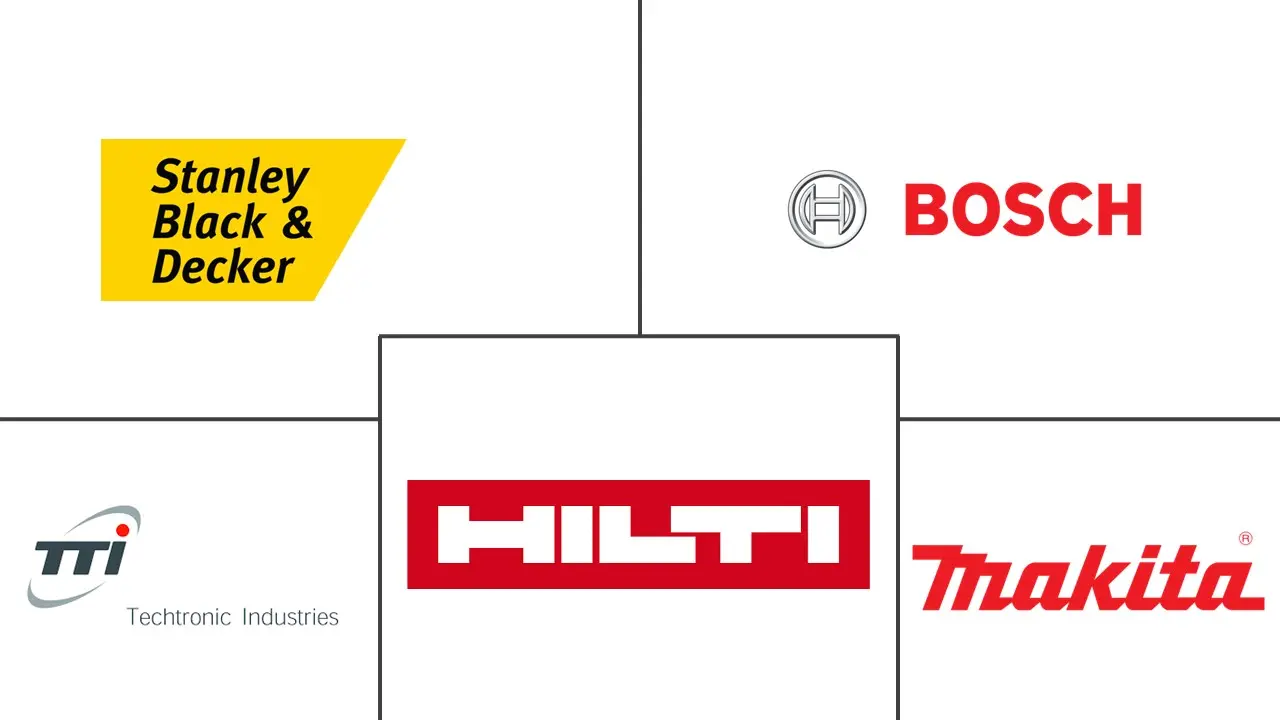Power Tools Market Size and Share
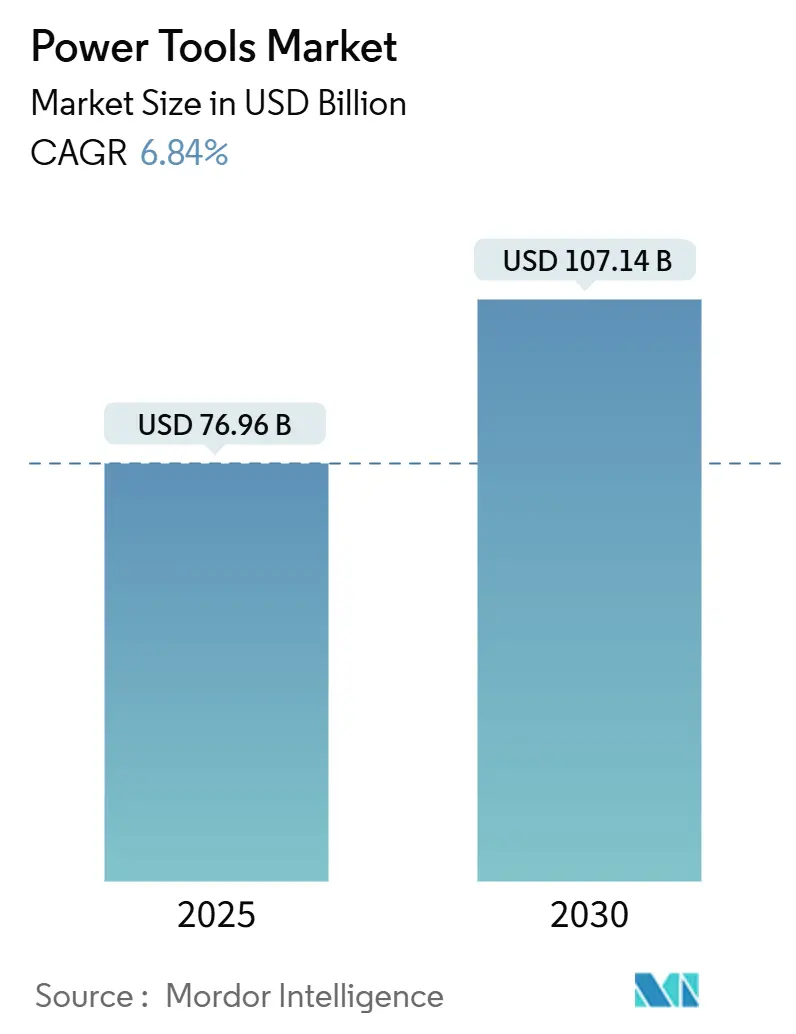
Power Tools Market Analysis by Mordor Intelligence
The Power Tools Market size is estimated at USD 76.96 billion in 2025, and is expected to reach USD 107.14 billion by 2030, at a CAGR of 6.84% during the forecast period (2025-2030).
Expanding infrastructure programs, rapid urbanization, and the shift toward cordless technologies sustain demand even as supply chains normalize. Cordless electrification is redefining job-site productivity, while stricter emissions rules in major cities accelerate the replacement of pneumatic and gas-powered units with battery platforms. Rising DIY participation and e-commerce access in emerging economies widen the consumer base, and smart manufacturing incentives in Asia and Europe stimulate factory‐floor investments in high-precision, connected tool systems. Competitive intensity remains moderate; leaders safeguard their share through differentiated battery ecosystems, whereas new Chinese entrants leverage localized production and aggressive pricing.
Key Report Takeaways
By mode of operation, electric tools led with 63.45% revenue share of 2024 in the power tools market, and cordless variants inside this category are clocking the fastest 7.5% CAGR through 2030.
By product, drilling and fastening captured 32.34% of the power tools market share in 2024; impact drivers and wrenches are expanding at an 8.1% CAGR to 2030.
By end-user, construction and infrastructure retained 46.76% of the power tools market size in 2024, whereas residential DIY is paced for 8.2% CAGR growth through 2030.
By sales channel, offline distribution held 79.88% share of 2024 in the power tools market; online platforms exhibit a 10.1% CAGR as manufacturers push direct-to-consumer strategies.
By geography, Asia-Pacific accounted for 39.86% 2024 revenue in the power tools market and is projected to post a 7.9% CAGR, underpinned by China’s industrial equipment upgrading plan and India’s Make in India push.
Global Power Tools Market Trends and Insights
Drivers Impact Analysis
| Driver | (∼) % Impact on CAGR Forecast | Geographic Relevance | Impact Timeline |
|---|---|---|---|
| Lithium-ion platform shift boosts cordless density | +1.3% | Global | Short term (≤ 2 years) |
| Electrification of construction equipment fleet | +1.2% | North America & Europe | Medium term (2-4 years) |
| Government incentives for smart manufacturing | +1.1% | China, EU, select emerging markets | Medium term (2-4 years) |
| DIY culture expansion via e-commerce | +0.9% | Asia-Pacific, global spill-over | Short term (≤ 2 years) |
| Automotive light-weighting elevates brushless precision | +0.8% | Global automotive hubs | Long term (≥ 4 years) |
| Modular, subscription-based tool-on-demand programs | +0.6% | North America & Europe | Long term (≥ 4 years) |
| Source: Mordor Intelligence | |||
Shift to Lithium-ion Battery Platforms Enabling Higher Power Density Cordless Tools
Cell chemistries continue to raise energy density by 5-7% annually, giving contractors similar runtime to corded equivalents with the benefit of untethered mobility. DEWALT’s tabless cell architecture boosts power 50% while shedding weight, allowing roofers and electricians to carry lighter packs without sacrificing torque.
Electrification of Construction Equipment Fleet in North America & Europe
Sixty-six percent of construction managers in the United States and Canada now expect fully electric jobsites within two years, citing emissions caps and lower lifetime running costs. European municipalities pursue similar goals; OEMs such as Volvo pledge all-electric line-ups by 2030 while mobile fast-charging rollouts shrink range anxiety. Urban projects increasingly specify battery or corded-electric tools, pressuring pneumatic and hydraulic segments yet leaving a niche for engine-driven units on remote sites lacking grid access. Contractors adopting all-electric fleets report up to 60% CO₂ savings and 30% shorter project timelines, reinforcing the payback narrative.
Government Incentives for Smart Manufacturing
China’s industrial equipment upgrading plan targets a 25% jump in capital spending by 2027, with a goal of 90% penetration of digital R&D tools in large enterprises. The EU’s Important Project of Common European Interest earmarks EUR 8.1 billion to microelectronics, unlocking private investment valued at EUR 13.7 billion and spurring demand for connected assembly solutions[1]Thierry Breton, “IPCEI ME/CT Funding Approval,” European Commission, ec.europa.eu. Fiscal credits and priority procurement accelerate the adoption of sensors, connectivity modules, and battery management systems embedded in next-generation power tools.
DIY Culture Expansion Fueled by E-commerce Penetration in Asia
Rising middle-class incomes, compact living spaces, and pandemic-era skill acquisition have turned DIY renovation into a mainstream pastime across India, China, and Southeast Asia. Direct-to-consumer storefronts on major marketplaces cut retail mark-ups, enabling budget-minded users to trial cordless kits previously considered professional-grade. Indian manufacturing clusters in Pune and Coimbatore have developed extensive battery-pack assembly capabilities under Make in India incentives, allowing domestic brands to meet demand locally while exporting competitively. Industry studies foresee gender neutrality in DIY participation by 2030, supported by ergonomic brushless models that reduce noise and vibration without compromising output.
Restraints Impact Analysis
| Restraint | (∼) % Impact on CAGR Forecast | Geographic Relevance | Impact Timeline |
|---|---|---|---|
| Volatility in lithium & cobalt prices inflating cordless BOM | -0.8% | Global battery-dependent lines | Short term (≤ 2 years) |
| Counterfeit supply undermines brand premiums | -0.5% | Emerging markets, online globally | Medium term (2-4 years) |
| Saturation of mature rental channels in Western Europe | -0.4% | Western Europe, select US metros | Medium term (2-4 years) |
| Regulatory actions on hand-arm vibration syndrome (HAVS) | -0.3% | Europe, spreading to OECD markets | Long term (≥ 4 years) |
| Source: Mordor Intelligence | |||
Volatility in Lithium & Cobalt Prices Inflating Cordless BOM Cost
US tariffs have lifted the composite duty on Chinese lithium-ion batteries to 58% in 2025, pressuring OEM margins and retail prices[2]Gina M. Raimondo, “Section 301 Battery Tariff Schedule,” U.S. Department of Commerce, commerce.gov. Battery inputs account for 30–40% of high-power cordless tool cost; spikes in spot prices force manufacturers to negotiate alternate offtake deals in Australia and Africa to secure supply and smooth pricing.
Saturation of Mature Rental Channels in Western Europe
Rental revenue growth decelerated to 1.9% in Q3 2024 as utilization plateaued at 63.4%, encouraging fleet right-sizing and consolidation among operators[3]Patrick G. Halpin, “2024 Rental Market Forecast,” American Rental Association, ararental.org. OEMs courting contractors directly through subscription models must invest in data platforms, logistics, and service infrastructure before revenue scales, moderating near-term returns.
Segment Analysis
By Mode of Operation: Cordless Revolution Accelerates
Electric formats captured 63.45% of 2024 revenue in the power tool market, with cordless sub-segments expanding at 7.5% CAGR through 2030 as lithium-ion packs approach corded performance parity. Pneumatic tools retain footholds where compressed-air systems already exist, and hydraulic devices address ultra-high-torque niches such as bridge tensioning. Engine-driven equipment is relegated to off-grid construction and forestry operations due to urban noise and emissions limits. The power tools market size for cordless solutions is projected to widen sharply as multi-brand battery alliances cut ownership costs and simplify charging infrastructure. However, raw-material pricing swings and limited fast-charging availability in developing regions keep corded units relevant for price-sensitive users.
Enhanced ergonomics, brushless drives, and firmware updates now differentiate premium cordless products. Bosch’s Professional 18V System and Makita’s LXT interchangeable packs highlight how ecosystem consistency locks in customer loyalty. Fleet managers appreciate the reduced downtime and safety gains derived from cable-free worksites, reinforcing the transition.

Note: Segment shares of all individual segments available upon report purchase
By Product: Impact Tools Drive Precision Demands
Drilling and fastening tools accounted for 32.34% of 2024 revenue in the power tool market, reflecting their ubiquity across construction and assembly lines. Impact drivers and wrenches register an 8.1% CAGR thanks to automotive and aerospace tightening specifications that require exact torque and data capture for traceability. Sawing and cutting remain resilient; carbide-tipped blades introduced by Bosch offer 20x life versus bi-metal alternatives, appealing to high-volume carpenters.
Regulations targeting HAVS prompt redesigns in demolition hammers; Bosch’s cordless GSH 18V-5 balances 8.5 J impact energy with adaptive speed control to mitigate vibration exposure. Emerging categories such as heat guns and cordless glue tools gain traction in decor and electronics rework, expanding the addressable universe beyond traditional construction trades. Collectively, premium brushless offerings underpin power tools market share retention for tier-one brands despite price competition.
By End-user: Construction Dominance Meets DIY Disruption
Construction and infrastructure projects delivered 46.76% of 2024 sales in the power tools market, supported by multiyear public works pipelines in Asia and North America. Yet the DIY channel, propelled by streaming tutorials and affordable cordless kits, delivers an 8.2% CAGR, reshaping marketing priorities. Professional builders value integrated battery fleets that reduce maintenance labor, while homeowners prioritize portability and user-friendly interfaces.
Automotive manufacturing remains a stable consumer of controlled-torque systems as EV adoption drives higher fastening counts per vehicle. Aerospace and defense maintain premium demand for calibrated tightening and documentation, boosting average selling prices. Manufacturing sub-sectors such as electronics and woodworking consume compact, low-torque drivers that integrate with automated lines. Across these verticals, the power tools market size for industrial users outpaces GDP as automation upgrades intensify tool replacement cycles.
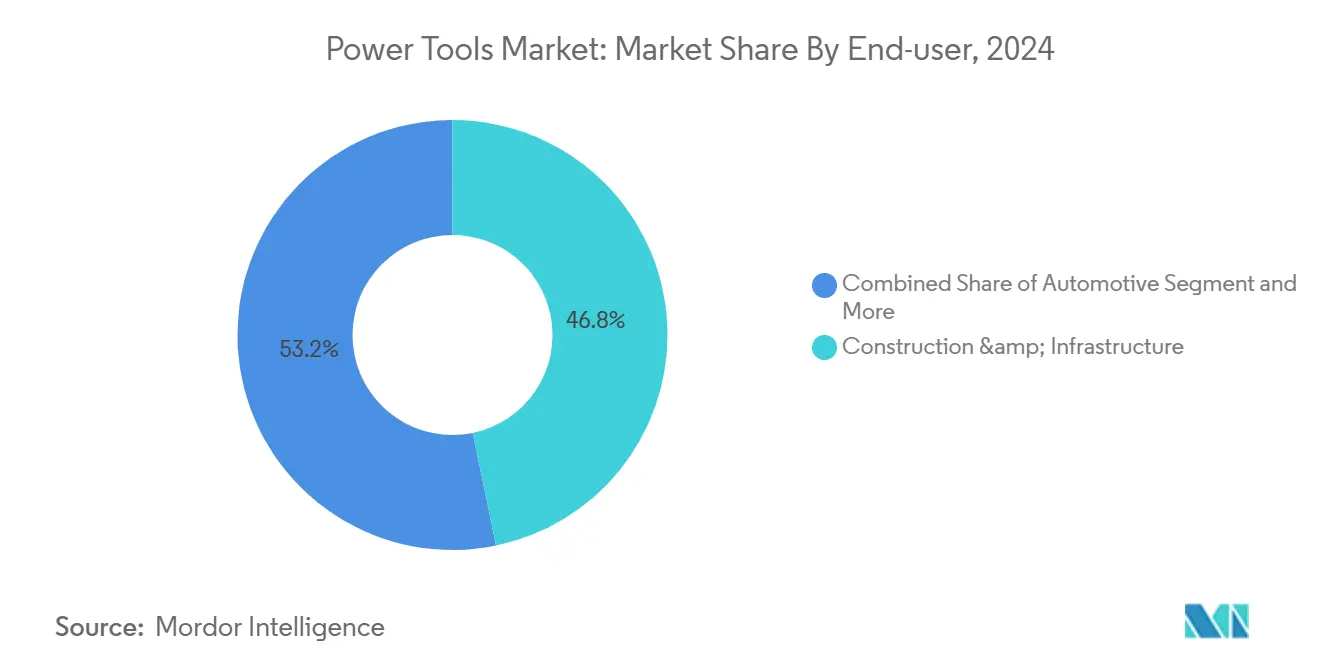
Note: Segment shares of all individual segments available upon report purchase
By Sales Channel: Digital Platforms Gain Momentum
Offline distribution retained 79.88% of 2024 revenue in the power tools market, underscoring the importance of brick-and-mortar dealers, big-box home centers, and industrial distributors that let buyers handle tools before purchase and negotiate bulk terms. Contractors still favor full-service dealers for job-site delivery, warranty processing, and credit facilities that pure-play digital outlets rarely match at scale. Mass-retail chains remain the primary gateway for first-time DIY purchasers, especially in regions where showrooming influences brand choice and accessory attachment rates. Within the offline arena, tool-truck fleets and specialty industrial houses differentiate on in-field calibration, repair, and safety-training services, advantages that help preserve margins even as price transparency rises. However, foot traffic is plateauing in mature Western markets, pushing store operators to integrate click-and-collect options and in-aisle mobile checkout to preserve share.
Online channels are advancing at a 10.1% CAGR to 2030, steadily enlarging the power tools market size for vendors that invest in omnichannel fulfilment and direct-to-consumer storefronts. Marketplace algorithms now surface mid-tier Asian brands alongside incumbents, compressing price gaps and accelerating cordless adoption among value-focused buyers. Manufacturers bolster loyalty with serialized tool registration portals that unlock extended warranties and push firmware updates, tactics that mimic consumer-electronics engagement models. United Rentals’ ProBox OnDemand shows how B2B customers embrace app-based lockers that automate inventory tracking and billing, further legitimizing digital procurement for heavy-duty fleets. High shipping costs for bulky items and the need for in-person technical guidance still temper online penetration in emerging markets, yet augmented-reality demos and regional service hubs are gradually narrowing these barriers.
Geography Analysis
Asia-Pacific held 39.86% of 2024 global revenue in the power tool market and is poised for a 7.9% CAGR, anchored by China’s 25% capital-investment hike under its upgrading plan and India’s Make in India incentives that draw both domestic and foreign OEMs[4]Xinhua Editors, “China Issues Industrial Equipment Upgrading Action Plan,” Xinhua News Agency, english.news.cn. Localized battery pack production and rising disposable incomes spur cordless adoption, while Japan’s mature yet innovation-centric market relies on premium brushless models to differentiate offerings.
North America constitutes a technologically advanced yet slower-growing region in the power tools market. The American Rental Association expects equipment rental revenue to climb to USD 77.3 billion in 2024, reinforcing a substantial recurring demand base. Nevertheless, tariffs on Chinese batteries inflate procurement costs, motivating near-shoring in Mexico, where tool imports surge double digits and supply chains reconfigure to sidestep duties.
Europe shows divergent trajectories in the power tools market: Western markets see rental channel saturation and strict HAVS regulation, whereas Eastern Europe benefits from EU funding and fresh manufacturing capacity. The EU’s EUR 8.1 billion IPCEI initiative stimulates smart-factory investments, generating demand for connected precision tools. Environmental compliance pressure favors electric models, and leading OEMs differentiate through low-vibration certifications and recyclable packaging.
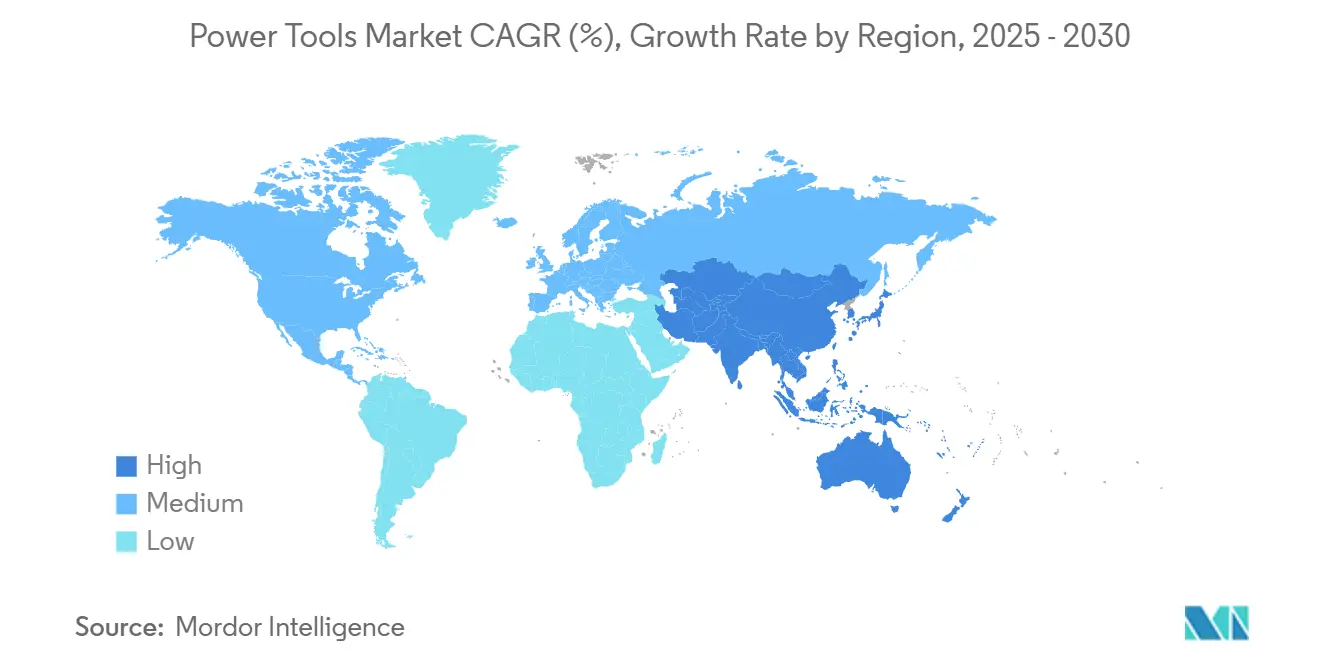
Competitive Landscape
The power tools market remains moderately concentrated. Stanley Black & Decker, Bosch, and Techtronic Industries collectively dominate premium price tiers but face share erosion from agile Chinese entrants employing regional assembly and price leadership. DEWALT’s POWERSHIFT cordless system promises up to 60% emissions cuts and has garnered high-profile innovation awards.
Bosch advances an open-platform battery alliance covering over 300 tools, reinforcing ecosystem stickiness. Techtronic Industries booked record USD 14.6 billion sales in 2024, leveraging Milwaukee’s contractor loyalty and tapping AI-driven data-center construction.
Industrial conglomerates continue acquisitive streaks: Atlas Copco’s bid for South Korean compressor producer Kyungwon and its earlier purchases in Colombia and Germany broaden cross-selling opportunities. Ingersoll Rand’s USD 135 million trio of hydraulic and pump deals strengthens niche positions and underlines the strategic value of specialty know-how. Subscription models, data analytics, and embedded IoT sensors represent the next battleground, requiring software skills historically outside traditional toolmakers’ core competencies.
Power Tools Industry Leaders
-
Stanley Black & Decker, Inc.
-
Robert Bosch GmbH
-
Techtronic Industries Co. Ltd.
-
Makita Corporation
-
Hilti Corporation
- *Disclaimer: Major Players sorted in no particular order
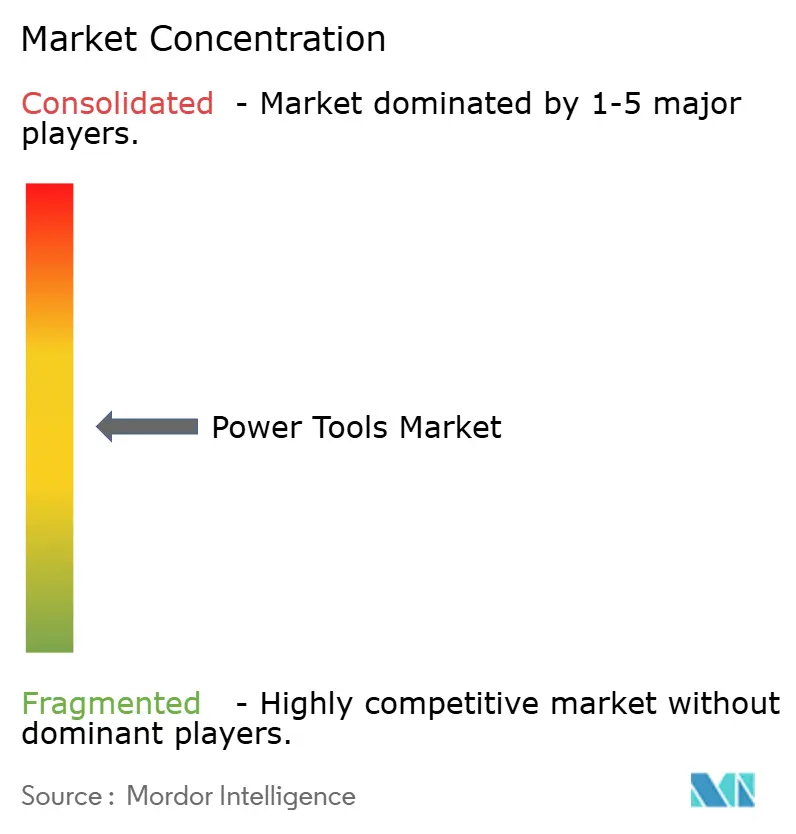
Recent Industry Developments
- May 2025: Hilti registered 1.5% local-currency sales growth for 2024, led by 5.9% expansion in Eastern Europe/Middle East/Africa.
- May 2025: Bosch launched the GSH 18V-5 cordless demolition hammer delivering 8.5 J impact energy with adaptive speed control.
- April 2025: Epiroc purchased STANLEY Infrastructure for USD 760 million, adding excavator attachments producing USD 450 million revenue in 2023.
- March 2025: DEWALT expanded its landscaping line with 28-in. gas and 60 V cordless mowers to serve the 81% of US households that maintain lawns.
Research Methodology Framework and Report Scope
Market Definitions and Key Coverage
Our study defines the global power tools market as every newly built hand-held or stationary device that draws electricity, compressed air, hydraulics, or small engines to replace manual effort in industrial, professional, or DIY tasks. The perimeter therefore spans drills, saws, grinders, impact drivers, nailers, wrenches, demolition, and material-removal tools, along with the integrated battery or motor shipped with each unit.
Scope exclusion: Rental revenue, stand-alone accessories, aftermarket parts, and medical or surgical powered instruments sit outside this assessment.
Segmentation Overview
- By Mode of Operation
- Electric
- Cordless
- Corded
- Pneumatic
- Hydraulic
- Engine-Driven
- Electric
- By Product
- Drilling & Fastening Tools
- Sawing & Cutting Tools
- Grinding & Polishing Tools
- Material Removal Tools (sanders, etc.)
- Demolition Tools (Breakers, Jackhammers)
- Impact Drivers & Wrenches
- Nailers & Staplers
- Others (heat guns, glue guns, mixers, speciality tools)
- By End-user
- Construction & Infrastructure
- Automotive
- Aerospace & Defense
- Energy & Power Generation
- Shipbuilding, Marine & Railways
- Manufacturing (Electronics, Metalworking, Wood Work, etc.)
- Residential / DIY
- Others (Utilities, Mining, etc.)
- By Sales Channel
- Offline
- Direct Industrial/ Distributor
- Mass Retail / Home Centers
- Online
- E-commerce Marketplaces
- Brand-Owned Digital Stores
- Offline
- By Region
- North America
- United States
- Canada
- Mexico
- South America
- Brazil
- Argentina
- Peru
- Rest of South America
- Europe
- United Kingdom
- Germany
- France
- Italy
- Spain
- BENELUX (Belgium, Netherlands, and Luxembourg)
- NORDICS (Denmark, Finland, Iceland, Norway, and Sweden)
- Rest of Europe
- Asia-Pacific
- China
- India
- Japan
- Australia
- South Korea
- ASEAN (Indonesia, Thailand, Philippines, Malaysia, Vietnam)
- Rest of Asia-Pacific
- Middle East and Africa
- Saudi Arabia
- United Arab Emirates
- Qatar
- Kuwait
- Turkey
- Egypt
- South Africa
- Nigeria
- Rest of Middle East and Africa
- North America
Detailed Research Methodology and Data Validation
Primary Research
Analysts followed up with interviews and short surveys of tool makers, lithium-ion cell vendors, distributors, and big-box buyers across Asia-Pacific, Europe, and North America. The conversations confirmed cordless penetration, average selling prices, and warranty return patterns that public data seldom covers.
Desk Research
We at Mordor Intelligence began by linking HS-level trade lines from UN Comtrade, US Census, and Eurostat with Federal Reserve industrial production, global housing-start trackers, and S&P Global PMIs to anchor demand. Open briefs from the European DIY Retail Association, patent logs, company 10-Ks, plus paid feeds such as D&B Hoovers and Dow Jones Factiva added pricing color and competitive intent. These titles are illustrative; many additional publications supported evidence collection.
Market-Sizing & Forecasting
A single top-down build adds thirty-five economies' factory output to net imports to derive apparent consumption. It then cross-checks totals against sampled average selling price × shipment snapshots, a focused bottom-up pass that trims variance. Predictor variables, housing starts, light-vehicle production, infrastructure capex pipelines, lithium-ion battery cost curves, and cordless share migration feed a multivariate regression that shapes the 2025-2030 outlook. Scenario analysis overlays policy or cycle shocks.
Data Validation & Update Cycle
Every model clears dual analyst review; material variances prompt rapid call-backs, and outputs are reconciled with third-party gauges before sign-off. We refresh figures annually and issue interim tweaks whenever recalls, major M&A, or regulation changes move the baseline.
Power Tools Numbers Clients Can Trust
Published estimates often diverge because researchers choose unequal tool baskets, freeze exchange rates on different days, or project history forward without field checks. Our disciplined scope, country-specific variables, and yearly refresh keep drift low.
Key gap drivers include studies that drop pneumatic or hydraulic units, overlook DIY retail, or assume flat battery costs, whereas Mordor's model blends housing, industrial output, and e-commerce penetration for every country.
Benchmark comparison
| Market Size | Anonymized source | Primary gap driver |
|---|---|---|
| USD 76.96 B (2025) | Mordor Intelligence | - |
| USD 39.50 B (2024) | Global Consultancy A | Excludes pneumatic & hydraulic units; constant 2023 FX |
| USD 32.95 B (2024) | Research Publisher B | Trend extrapolation; minimal primary checks |
| USD 28.56 B (2024) | Industry Insights C | Factory-gate shipments only; DIY retail omitted |
Together, the comparison shows that our transparent variables and multi-source triangulation give decision-makers a balanced, repeatable baseline they can rely upon.
Key Questions Answered in the Report
What is the current value of the power tools market?
The market is valued at USD 76.96 billion in 2025 with a forecast to reach USD 107.14 billion by 2030.
Which segment is growing fastest within the power tools market?
Cordless electric tools show the highest growth, advancing at a 7.5% CAGR through 2030 as battery performance and charging infrastructure improve.
Why are impact drivers and wrenches gaining popularity?
Automotive light-weighting and aerospace precision demands require high-torque, brushless impact tools that deliver accurate fastening and data traceability.
How is government policy influencing demand?
Programs such as China’s industrial upgrading plan and the EU’s IPCEI project provide tax incentives and grants that accelerate adoption of smart, connected manufacturing tools.
Page last updated on:
